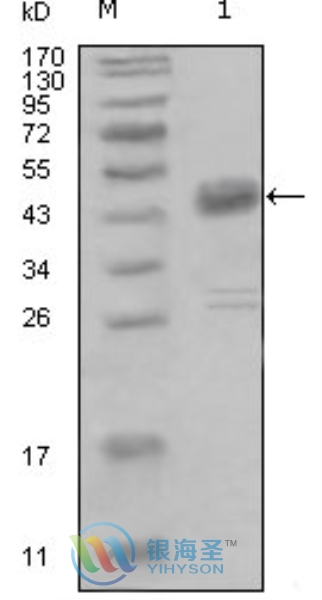AMM5530-61
[Monoclonal Antibody]
DDR1 Mouse Monoclonal Antibody

www.yhsbio.com
market@yhsbio.com
support@yhsbio.com
+86-21-54651191
Room 703,Building 6,333# Guiping
Rd.,Xuhui District,Shanghai,China
market@yhsbio.com
support@yhsbio.com
+86-21-54651191
Room 703,Building 6,333# Guiping
Rd.,Xuhui District,Shanghai,China
DATASHEET
| Species: | Mouse |
| Applications: | WB ELISA |
| Immunogen Range: | A purified recombinant fragment of human DDR1 expressed in E. Coli |
| Clonality: | Monoclonal Antibody |
| Isotype: | IgG1 |
| GENE ID: | 5530 |
| Swiss Prot: | Q08345 |
| Synonyms: | CAK, CD167a antigen, Cell adhesion kinase, Discoidin receptor tyrosine kinase, EC 2.7.1.112, EC 2.7.10.1, EDDR1, Epithelial discoidin domain receptor 1 precursor, HGK2, Protein-tyrosine kinase RTK 6, RTK6, TRK E, TRKE, Tyrosine kinase DDR, Tyrosine- prote |
| Purification: | Affinity chromatography |
| Storage: | Store at -20°C or -80°C in PBS with 0.02% sodium azide and 50% glycerol. Avoid freeze/thaw cycles. |
| Background: | Receptor tyrosine kinases (RTKs) play a key role in the communication of cells with their microenvironment. These molecules are involved in the regulation of cell growth, differentiation and metabolism. The protein encoded by this gene is a RTK that is widely expressed in normal and transformed epithelial cells and is activated by various types of collagen. This protein belongs to a subfamily of tyrosine kinase receptors with a homology region to the Dictyostelium discoideum protein discoidin I in their extracellular domain. Its autophosphorylation is achieved by all collagens so far tested (type I to type VI). In situ studies and Northern-blot analysis showed that expression of this encoded protein is restricted to epithelial cells, particularly in the kidney, lung, gastrointestinal tract, and brain. In addition, this protein is significantly over-expressed in several human tumors from breast, ovarian, esophageal, and pediatric brain. This gene is located on chromosome 6p21.3 in proximity to several HLA class I genes. Three isoforms of this gene are generated by alternative splicing. [PROW] |
| Caculated MW: | 101 kDa. |
| Observed MW: | Refer to Figures |
| Applications: |
WB 1:500-1:2000 |
| Reacitivity: | Human |
For research use only. Not intended for diagnostic or therapeutic use!
Additional information
